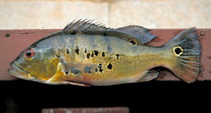| Family: |
Cichlidae (Cichlids), subfamily: Cichlinae |
| Max. size: |
74 cm TL (male/unsexed); max.weight: 6,800.0 g |
| Environment: |
benthopelagic; freshwater; brackish; depth range - 5 m |
| Distribution: |
South America: Marowijne drainage in Suriname and French Guiana to the Essequibo drainage in Guyana. |
| Diagnosis: |
Diagnosis. Distinguished from all other species of Cichla except C. nigromaculata, C. intermedia, C. piquiti, and C. melaniae, by presence of bars 1a and 2a. Lateral band abbreviated in juveniles. Distinguished from its congeners with abbreviated lateral band by lateral line usually continuous (vs. discontinuous or nearly always discontinuous in orinocensis and nigromaculata; scales in E1 row (67-) 70-80 (-82) (vs. 84-93 in pleiozona); occipital bar absent or indistinct (vs. emphasized in adults of monoculus, kelberi, and pleiozona); abdominal blotches present (vs. absent in orinocensis); vertical bars present at adult size (vs. three midlateral ocellated blotches in orinocensis), except that an ocellated blotch consistently formed in dorsal portion of bar 3; absence of small black blotches on dorsum (vs. present in nigromaculata); vertical bars about equally wide across side (vs. wide, occasionally confluent dorsally, and tapering ventrad in nigromaculata, monoculus, kelberi, and pleiozona. Distinguished from C. intermedia, C. piquiti, and C. melaniae by abbreviated vs. complete juvenile lateral band, less scales in E1 row (67-82 vs. (78) 83-108), and presence of ocellated blotch in dorsal portion of bar 3 vs. absence (Ref. 57716).
Description: Appears basically yellow with a dark green back and white belly; eyes reddish with several dark vertical bands extending partially down the sides of the body; males with prominent hump on the nape; distinct black "eye spot" on the tail, from which the fish got its name (Ref. 44091). |
| Biology: |
Occurs in the rapids, in quiet waters with medium depth and rocky substrates (Ref. 35237). Forms schools (Ref. 9086). Feeds only on small fish, especially threadfin shad, mosquito fish, tilapia and bluegill. Not considered ideal for aquaculture due to its highly predatory habits (Ref. 1739). Reproduction occurs year-round, with a peak at the start of the rainy season. About 9,000 to 15,000 eggs per kg are released during spawning. Spawning takes place every two months on a flat stone in shallow water. The sticky eggs, measuring 1.4 mm in diameter, take 78 hours to hatch at 28°C. |
| IUCN Red List Status: |
Least Concern (LC); Date assessed: 05 November 2020 Ref. (130435)
|
| Threat to humans: |
potential pest |
| Country info: |
|
Source and more info: www.fishbase.org. For personal, classroom, and other internal use only. Not for publication.

